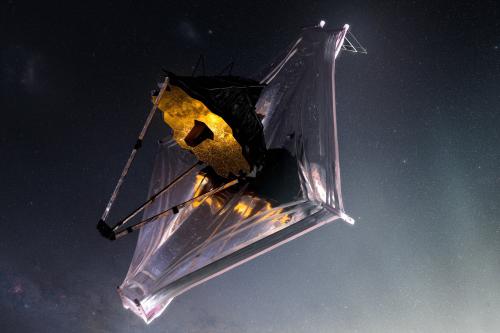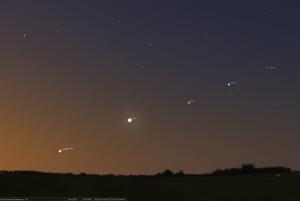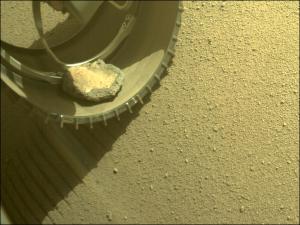Celebration of Space - June 10, 2022
On the James Webb Space Telescope (JWST) front, everything continues to be awesome. Though in late May 2022, the observatory sustained a larger-than-expected meteor strike. Now JWST is obviously built with the expectation that tiny (dust-sized), fast moving meteor impacts will occur. Though the late May impact was big enough to noticeably damage one of the primary mirror segments. The damage was significant enough to require additional alignment procedures to correct for the anomalies that were introduced as a result. Even with the impact damage, JWST continues to perform at better-than-expected levels. To put this type of event into perspective, Earth is bombarded with over 100 tons of dust – sand sized meteors per day! The seemingly emptiness of space is really not all that empty in reality. During meteor showers, this activity will increase, and the JWST is designed to re-orientate itself during these showers to protect the primary mirror and scientific instruments. Though larger than expected random meteors do happen, and rather frequently. These are some of the challenges that the JWST, and human space travel have to deal with. For now, the JWST is brushing off this little event, and everything continues on schedule for the July 12, 2022 first image release date.
Starting this morning, June 10, 2022, the fabulous ongoing planetary conjunction in the morning sky stepped it up a notch when Mercury joined in. Over the next few weeks, Mercury will be part of the conjunction, and will become brighter and higher off the horizon. Best viewing of Mercury will be around June 22, 2022. The addition of Mercury to the conjunction puts all naked-eye visible planets into the morning sky at the same time. Though it may still be a bit early to catch a view for most New England sky watchers, in Rhode Island, we have so much coastline that getting a super low predawn view over the horizon should not be that difficult. Point Judith and Beavertail immediately come to mind. Regardless of how, where, or when you choose to view, this is a fantastic event and you should really try to get out one morning for a look-see. When observing, note that the planets will stretch from the ESE horizon to the southern sky about 30° above the southern horizon. The order of the planets from east to west are: Mercury, Venus, Mars, Jupiter, and Saturn.
This coming Tuesday, June 14, 2022 at 7:53 am the June Full Moon will occur. Commonly referred to as the Full Strawberry Moon, the June Moon is quite notable because it will be the lowest altitude of all full lunar phases of the Northern Hemisphere year. This is a result of the June Moon occurring so close to the Summer Solstice. During the Summer Solstice the Sun reaches its highest point in the Northern Hemisphere sky (23.4° above the celestial equator). Alternatively, since the Moon orbits Earth 5.1° inclined to the ecliptic (the path the Sun takes across the sky), the Moon will be at its lowest point in the Northern Hemisphere night sky on the Summer Solstice. Because the bright Moon is so low in the sky, it becomes more vulnerable to Rayleigh Scattering, which is when the air in Earth’s atmosphere scatters blue light. This effectively filters out a lot of the blue light when observing objects low on the horizon. If the observer’s location is humid or ozone levels are up in the city, further scattering of blue light will occur. This can cause the Moon to appear a rather golden – orange color during most of the June full Moon. The Strawberry Moon name is quite obvious for anybody who has wild strawberries growing in their yard, as this is the time of year that the strawberries come out. So take a moment this coming Tuesday, around 10:00 pm, to step outside, perhaps with a strawberry to snack on, and catch a view of the rather golden Strawberry Moon, and enjoy the last full Moon of spring.
Another piece of lunar goodness is that the Full Strawberry Moon of June 2022 is also happening about 10.5 hours before the monthly lunar perigee, which is when the Moon is at its closest point to Earth for its 27.3 day orbit. The scientific name for this event is called a Perigee-Syzygy, though you have probably heard of it referred to as a Super Moon. What does this mean to a regular sky watcher? Really nothing noticeably, though the Moon will be about 14% larger than it would appear during the Apogee-Syzygy, which is also called a Micro Moon, and about 30% brighter. But this is not as noticeable as it sounds because the Micro Moon occurred six months ago. Compared to last month’s full Moon, the June Moon will appear only about 1% brighter and a fraction of a percent larger. Which is certainly unnoticeable. Regardless, I will hear from many that the Moon is the brightest Moon they have ever seen. The power of suggestion is astounding. In any case, even if you do think it’s the brightest Moon you have ever seen, that is fine with us, as getting out and looking at the Moon is one of those amazing things about being part of Earth, and your perception of that sight is one of the great things about being human. The Moon is the only celestial object that we can see surface detail with the naked eye. So enjoy it in whatever way works best for you.
On a fun side note, remember that new rover that joined the rover party on Mars? NASA’s Perseverance rover, which has been trekking around on Mars now for over 464 Martian days (sols), has picked up a little buddy. Check out this image. Perseverance has a rock that has been riding along in its front left wheel. The rock has been there for the past 100 sols, and has traveled a distance upwards of 5.3 miles with the rover. Hey everyone needs a friend sometimes, and Perseverance and the rock seem to have clicked. This isn’t the first time a rover has befriended a rock, though this rock has been with Perseverance for some time and it appears to be sticking around. Here is another, wider field, image of the little buddy. Keep up with the fabulous Perseverance mission here.
- Author:
- Scott MacNeill
- Entry Date:
- Jun 10, 2022
- Published Under:
- Scott MacNeill's Columns





